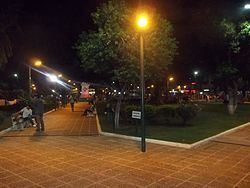Country Argentina Founded 1924 CPA base A4560 Elevation 490 m Province Salta Province Local time Monday 12:41 AM | Department San Martín Time zone ART (UTC-3) Dialing code +54 3875 Area 3,015 km² Population 69,696 (2012) Number of airports 1 | |
 | ||
Weather 21°C, Wind SW at 6 km/h, 97% Humidity | ||
Tartagal ([tartaˈɣal]) is a city in the north of the province of Salta, Argentina, 365 km from the provincial capital. It has over 60,000 inhabitants as per the 2001 census , and it is the head town of the General José de San Martín Department (with about 3/4 of its population). It is crossed by the river of the same name.
Contents
Map of Tartagal, Salta Province, Argentina
Tartagal is located in an area of major economic importance for the province, within Argentina's second largest natural gas reservoir, and at a crossroads for trade in the Mercosur (being only 55 km from the border with Bolivia and 100 km from Paraguay). The area produces 25% of the oil and about 16% of the natural gas in Argentina.
Social Composition
The social composition of Tartagal is characterized by its cultural diversity. There are seven aboriginal ethnic groups that reside in Tartagal: wichís (or weenhayek), chiriguanos, chanés, quechuas, chorotes, chulupíes and Aymaras. Another important element of its social structure is the migratory component that is added to its population. Because of it is so close to Bolivia, a high percentage of its inhabitants are of Bolivian origin. Tartagal was the main destination of immigration of the peasant-livestock population of the east (commonly known as "Chaco") that settled, like the Aboriginals, in neighborhoods surrounding the city. It also has important foreign communities including: Syrian-Lebanese, Paraguayan, and Spanish. Tartagal has a diverse population and many cultural nuances
Population
The last census, in the year 2010, the city of Tartagal had a population of 64,530 inhabitants, becoming the third most populated city of its province, surpassed only by the provincial capital and by San Ramón de la Nueva Orán.
History
Tartagal derives from the tártago plant (Euphorbia lathyris, a kind of spurge). The area of modern Tartagal appears with this name in legal documents for the first time in 1853. At the time the area belonged to the Tarija Department, Bolivia. The foundation date of the town, however, is acknowledged as June 13, 1924; the municipality was created soon afterwards, and Tartagal attained city status only on September 22, 1949.
The Argentine Army has the 17th Jungle Cazadores Company (Compañía de Cazadores de Monte 17) based at Tartagal.
At the beginning of the 20th century, important oil deposits were discovered which lead to the founding of Yacimientos Petrolíferos Fiscales (YPF). YPF was founded by Hipólito Yrigoyen in the 1922, and later privatized in 1992, was highly valued during the governmental terms of Juan Domingo Perón between the 40s and 50s. It was out-competing Standard Oil, in terms of production as well as in terms of social impact, since it ensured work, social security, education for the worker’s children and dozens of benefits that dignified the lives of workers, not counting the commercial flow that positively impacted the area.
Petroleum was discovered here at the beginning of the 20th century. Since 1926 the state-owned oil company YPF employed or indirectly supported most of the local population. In 1992 the company was privatized (becoming Repsol-YPF) and 90% of its workers were fired, prompting violent social conflicts and, a few years later, the appearance of piquetero (unemployed workers) movements, similarly to what happened also in other oil-producing areas like Cutral-Co, Neuquén, and in the neighboring General Mosconi.
On November 12, 1966 at a solar eclipe several sounding rockets were launched from Tartagal for solar research.
On February 9, 2009, heavy rains caused the Tartagal River to break its banks and flood much of the city, resulting in 11 casualties.
